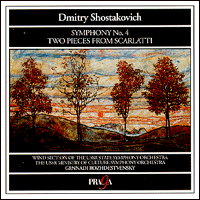
SHOSTAKOVICH
Symphony No. 4
in C minor, Opus 43 (1935-6)
*Two Scarlatti Pieces, Op.
17
(1928)
USSR Ministry of Culture Symphony Orchestra
*USSR
State
Symphony Orchestra Wind Section
cond. Gennadi
Rozhdestvensky
Praga PR 250090 [73:40/ADD]

SHOSTAKOVICH
Symphony No. 4
in C minor, Opus 43 (1935-6)
*Two Scarlatti Pieces, Op.
17
(1928)
USSR Ministry of Culture Symphony Orchestra
*USSR
State
Symphony Orchestra Wind Section
cond. Gennadi
Rozhdestvensky
Praga PR 250090 [73:40/ADD]
Rozhdestvensky's third version of the Fourth Symphony to be issued on CD is at once his most extreme and most compelling. His view of the work has always been marked by vivid characterisation among the wind instruments, especially during the "divertissement" section of the finale (where, in a passage which conceivably represents Shostakovich's censure at the Composers' Union in 1936, the conductor discloses an extraordinary gallery of Dickensian grotesques). This consciously dramatic approach applies more than ever to the present issue. Mahler wrote symphonies which took up whole evenings - more like symphonic "happenings" than anything his forerunners in the idiom would have recognised. When Rozhdestvensky conducts Shostakovich's Fourth, we hear the stirrings of another (sadly stillborn) new genre: "symphony-theatre" - a hybrid of symphony and stage music which proceeds in a sequence of tableaux, loosely organised by sonata principles and marked by a high incidence of solo or chamber music groupings, as if embodying dialogues, dances, and snatches of song played out before the backdrop of the main orchestra.
Rozhdestvensky's recorded attempts on this symphony, which clearly holds an abiding fascination for him, have hitherto bristled with personality but suffered either from eccentric engineering or an occasional loss of ensemble in tutti passages. His 1984 version with the USSR Ministry of Culture Symphony Orchestra (Olympia OCD 156) is garishly spotlit and reverbed in the unrealistic style favoured by Russian producers; yet anyone who can put up with weirdly haloed high strings, ballooning solo instruments, and sometimes leisurely tempos, will learn a lot about the score from this disc. Rozhdestvensky's second release, a "live" 1981 recording with, appropriately, the Bolshoi Theatre Orchestra (Russian Disc RDCD 11190) is just as prone to production quirks, but more impulsively Kondrashin-like in attack. Were it not for the fact that ensemble keeps coming unstuck at fortissimo - muddling some of Shostakovich's greatest orchestral coups - this would be the only convincing rival to Kondrashin (Melodiya 74321-198402). As it is, Rozhdestvensky is uniquely in touch with the composer's satirical streak and again obtains some stunning characterisations from his wind players.
The new version from Praga, which finds Rozhdestvensky back with the USSR Ministry of Culture Symphony Orchestra in a Czech concert broadcast of 1985, is as bizarre as its predecessors in terms of production, the violins often sounding as if recorded in an adjoining railway terminus. It is also, at times, peculiarly slack in tempo (e.g., the finale's opening slow-march and 3/4 allegro sections), while the audience is loudly cough-prone and erupts in raucous applause before the last note has faded. Despite these drawbacks, this is a fascinating performance which will absorb anyone who especially loves this symphony (which means those who already possess, at the very least, the classic Kondrashin version).
Never has this symphony seemed more Kafkaesque, nor its "symphony-theatre" concept more riveting. So hypnotic is Rozhdestvensky's concentration that the audience's rasps and splutters, which break out on cue between movements, quickly die away as the music grips their attention. Tempi are often slowed so as to point up nuances of phrasing, timbre, and balance - and here the clarity of effect is positively hallucinatory. It is as if, in a sinister twilight, Mahlerian unease blends with the harlequin world of Pulcinella. (The neoclassical influence of Stravinsky is underlined by the filler, Shostakovich's wind-band orchestrations of two Scarlatti sonatas, which, anticipating the symphony, treat each contrapuntal strand as an individual voice with its own character.)
The antithesis of the delusory "pure music" approach to Shostakovich - as demonstrated, for example, by Eliahu Inbal's limp reading on Denon - this performance shows Rozhdestvensky producing fresh insights from every corner of an astounding score. Very different in pace and stress from Kondrashin's, this reading often gets in deeper and, at its best, makes his solutions seem, imaginatively, somewhat superficial. Though not a first - and certainly not an only - buy, this is well worth considering if you put music ahead of top quality sound and can afford two or more recordings.